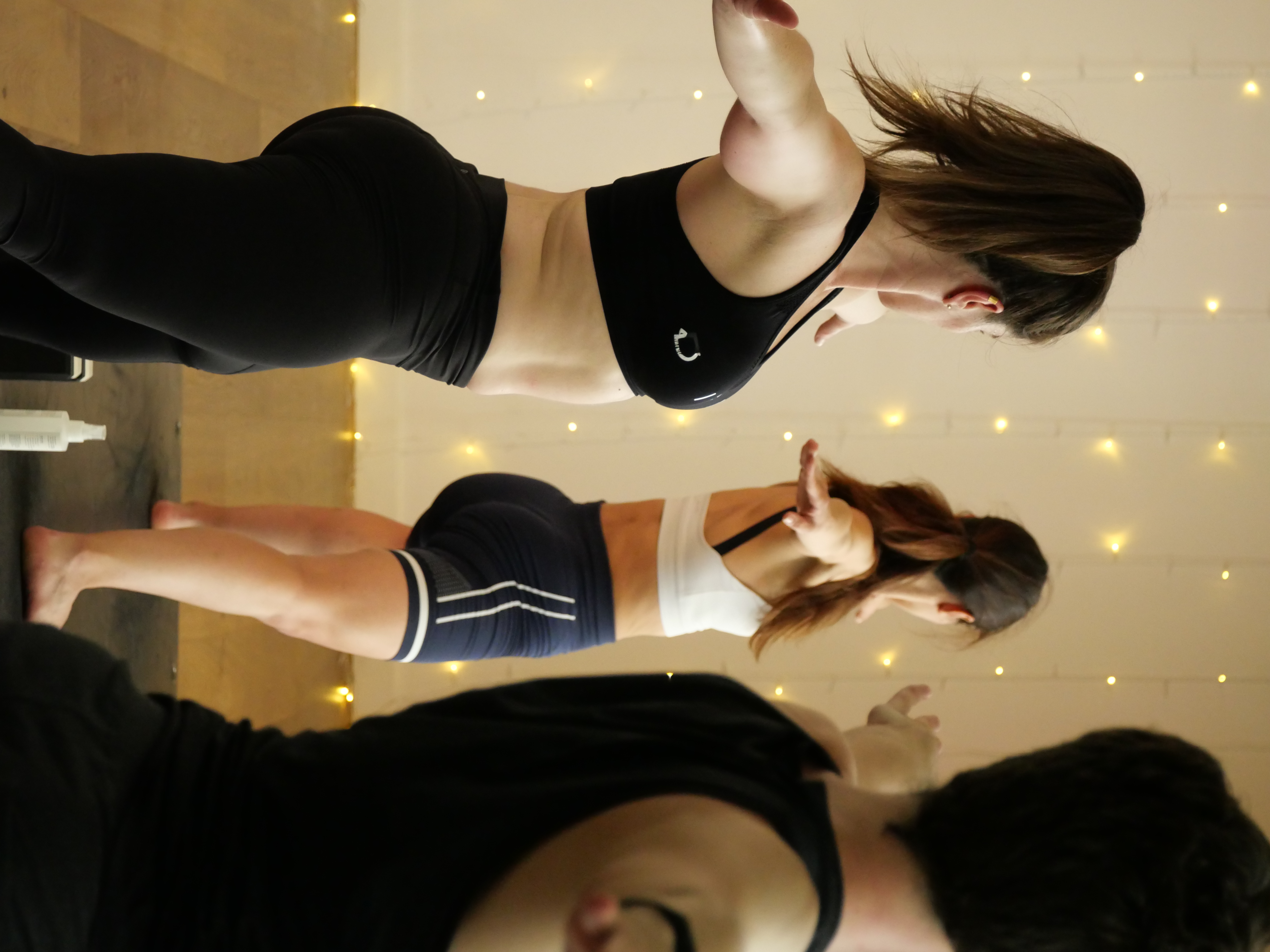Popular Yoga Poses Explained
There is an incredible range of yoga poses and sequences that can make Yoga intimidating for the newcomer. In this blog, we explain some of the most common yoga poses so that if you're new to class, the names of these poses don't come as a complete surprise!
Here are some of the most popular yoga poses:
-
Downward-Facing Dog (Adho Mukha Svanasana) - Downward Dog is a popular yoga pose that is often used as a transition between other poses. The pose strengthens the arms, shoulders, and legs while stretching the hamstrings, calves, and hands. It is considered a foundational pose in many yoga styles, such as Vinyasa, Ashtanga, and Hatha yoga.
To enter the pose, start on all fours with your wrists directly under your shoulders and your knees directly under your hips. Tuck your toes under and lift your hips up and back, coming into an inverted "V" shape.
Straighten your arms and legs, pressing firmly through your hands and feet. Bring your head towards your knees, and press your heels towards the ground.
Hold the pose for several deep breaths, then release. It's important to keep your shoulder blades down and away from your ears and to keep your core engaged to avoid any strain on your lower back.
-
Warrior II (Virabhadrasana II) - Warrior II is a standing yoga pose that is named after the warrior Virabhadra, a fierce incarnation of the Hindu god Shiva. The pose strengthens the legs, arms, and core while stretching the chest, lungs, and shoulders.
To enter the pose, start by standing at the top of your mat with your feet hips width distance apart. Turn your right foot out 90 degrees and your left foot in slightly. Bend your right knee, making sure that your knee is directly above your ankle and your thigh is parallel to the ground.
Stretch your arms out to either side, with your right arm in front of you and your left arm behind you. Your arms should be parallel to the ground and your shoulders should be relaxed. Your gaze should be over your right hand.
This pose strengthens the legs, arms, and core while stretching the chest, lungs, and shoulders.
-
Triangle Pose (Trikonasana) - Triangle Pose is a standing yoga pose that strengthens the legs, core, and arms while stretching the hamstrings, hips, and spine. The pose is named for the triangular shape that the body forms during the pose.
To enter the pose, start by standing at the top of your mat with your feet hips width distance apart. Turn your right foot out 90 degrees and your left foot in slightly. Extend your arms out to the sides, parallel to the ground, and then reach forward with your right hand and place it on your right ankle, shin or knee.
Keep your left arm straight and reach it up towards the ceiling. Turn your head to look up at your left hand.
Hold the pose for several deep breaths, then release and repeat on the other side.
It's important to keep your front knee facing forward, engage your core and to make sure that your back is straight and hips facing forward to avoid any strain on your back.
This pose strengthens the legs, core, and arms while stretching the hamstrings, hips, and spine.
-
Tree Pose (Vrikshasana) - Tree Pose is a standing yoga pose that strengthens the legs and core while improving balance and stretching the inner thighs. The pose is named for the tree-like appearance of the body during the pose.
To enter the pose, start by standing at the top of your mat with your feet hips width distance apart. Shift your weight onto your left foot and bend your right knee, bringing the sole of your right foot to the inner thigh of your left leg.
Press your foot firmly against your thigh and engage your core to help keep your balance. Bring your hands together in front of your chest in prayer position or raise them up above your head with your palms together.
Gaze at a fixed point in front of you to help with balance. Hold the pose for several deep breaths, then release and repeat on the other side.
It's important to keep your standing knee facing forward, engage your core and to make sure that your hips are facing forward to avoid any strain on your back.
This pose strengthens the legs and core while improving balance and stretching the inner thighs.
-
Cobra Pose (Bhujangasana) - Cobra Pose is a yoga pose that strengthens the back and core while stretching the chest and shoulders. The pose is named for the cobra, as the body resembles a snake ready to strike.
To enter the pose, start by lying on your stomach with your hands next to your shoulders and your elbows close to your body. As you inhale, press into your hands and lift your chest off the ground, keeping your elbows close to your body.
Keep your shoulders relaxed and your gaze forward. Press your tailbone towards the ground and engage your core muscles.
Hold the pose for several deep breaths, then release. It's important to keep your elbows close to your body, avoid over-arch your back and to keep your core engaged to avoid any strain on your lower back.
-
Child's Pose (Balasana) - Child's Pose is a gentle way to stretch the back, hips, and thighs while calming the mind. The pose is named for the way a child might sit, with the knees close to the chest and the forehead resting on the ground.
To enter the pose, start on all fours with your wrists directly under your shoulders and your knees directly under your hips. Sit back on your heels and then lower your torso to rest on your thighs.
Extend your arms out in front of you and rest your forehead on the ground. Relax your entire body and breathe deeply.
Hold the pose for several deep breaths, then release. It's important to keep your hips sitting on your heels and to make sure that your back is relaxed to avoid any strain on your lower back.
-
Half Lord of the Fishes Pose (Ardha Matsyendrasana) - Half Lord of the Fishes Pose is a seated yoga twist that is a great way to stretch the spine and shoulders while improving digestion. The pose is named after the Indian sage Matsyendranath, the founder of Hatha Yoga and credited with the creation of many of the asanas.
To enter the pose, start by sitting on the floor with your legs extended in front of you. Bend your right knee, and bring the right foot to the outside of your left knee.
Then, cross your left elbow to the outside of your right knee and press your right hand against the floor behind your back. Slowly twist your torso to the right and gaze over your right shoulder.
Hold the pose for several deep breaths, then release and repeat on the other side.
It's important to keep your spine straight, engage your core and to make sure that your shoulders are relaxed to avoid any strain on your back or neck.
-
Camel Pose (Ustrasana) - Camel Pose is a deep heart opener that strengthens the back and core while stretching the front of the body. The pose is named after the hump of a camel, as the pose resembles a camel raising its hump.
To enter the pose, start on your knees with your shins and tops of your feet touching the floor. place your hands on your lower back, with your fingers pointing downwards.
Slowly begin to arch your back and reach backwards with your hands to grab hold of your heels. Arching your back as much as possible, keep your head facing forward, and your gaze directed towards the ceiling.
Hold the pose for several deep breaths, then release. It's important to keep your core engaged, your lower back muscles relaxed and to make sure that your hips are facing forward to avoid any strain on your lower back. If you have any lower back pain or knee issues, it's best to avoid this pose or to practice it with caution under the guidance of a certified yoga instructor.
-
Headstand (Sirsasana) - Yes, Headstands are in fact yoga poses! A Headstand is a yoga pose that strengthens the shoulders, arms, and core while improving balance and focus. It is considered an advanced pose and should be practiced with caution and under the guidance of a qualified instructor.
To enter the pose, start in a kneeling position with your hands on the floor, interlacing your fingers. Place the crown of your head on the floor, with your fingers supporting the back of your head.
Slowly begin to lift your hips and legs off the ground, using your core and arm strength to support you. Once in the full pose, your body will be in an inverted "V" shape with your legs and hips stacked above your shoulders and head.
Hold the pose for several deep breaths, then release. It's important to keep your core engaged and your neck protected, to avoid any strain or injury. It's also essential to practice the preparatory poses and to master the proper technique before attempting this pose.
-
Savasana (Corpse Pose) - Savasana is a yoga posture that is typically practiced at the end of a yoga session. It is a relaxation pose that is meant to bring the body and mind to a state of complete rest and rejuvenation.
In savasana, the body is lying on the back with the arms and legs slightly apart and the palms facing up. The eyes are closed, and the focus is on deep breathing and relaxation. The posture is meant to release tension and stress from the body and mind and to bring about a sense of calm and peace.
Savasana is considered to be one of the most important postures in yoga. It allows the body to absorb the benefits of the previous postures and to integrate the physical, mental and emotional changes that have occurred during the practice. It is also a good opportunity to practice mindfulness and meditation.
It is usually held for 5-15 minutes, but can be held longer depending on the teacher or the practice. It's a time to let go of the day and to prepare for a good night rest.
It's important to remember that everyone's body is different and some poses may be more or less challenging for different people. Always listen to your body and modify poses as needed.






COMMENTS (0)
Be the first to comment!
Please login to comment